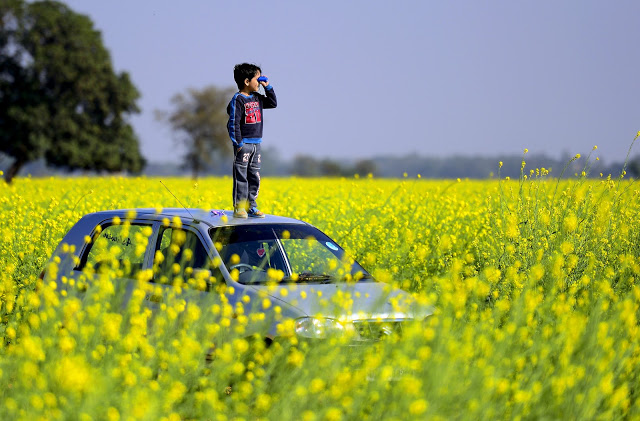“To see the world in a grain of sand, And heaven in a wild flower,
Hold infinity in the palm of your hand, And eternity in an hour.”
For 200 years, these words have ignited the spiritual imagination of people the world over. Like a philosopher’s stone that transmutes base metal into gold, Blake’s words have the power to transform and uplift human life, to unfetter and set free the soaring spirit of the higher mind—without leaving anything out or behind, staying fully present in the body with feet on the ground.
A few years ago, I met 123 Blakes, kids from two to 12 years of age. I interviewed them for a book I co-authored, “The Spiritual Wisdom of Kids.” Each and every one of them confirmed the majestic beauty of Blake’s famous lines. Also, these kids (they preferred “kids” to “children”) I spoke with had Blake’s power, too, for they pulled their wisdom from the same well as Blake pulled his. In the same way we learn from Blake, we can learn from these kids. They are wild flowers from heaven.
There is something remarkable about kids the world over: they experience life in a way that expresses deep and profound wisdom. Their wisdom is born of their own connection to life and to living things. Children, especially infants, still glow with a pure and innocent light; and it is their shining light that causes us to stop and stare and smile, because in that moment we step out of time and into a timelessness where we are warmed by secrets we, too, once knew and can remember again through the grace of children.
As I reflect on the many things I learned from speaking with these kids, one of their teachings stands taller than the others: empathy. They have empathy for all things in creation. Empathy is not sentimental; it is not emotional imagination. Empathy is “the action of understanding, being aware of and sensitive to, and vicariously experiencing the feelings, thoughts and experience of another…”
Synonyms of empathy include words like communion, unity, harmony, kinship and oneness. The kids feel and identify with the spirit, soul, and personality within all living things, and this living spirit is what they call God. For them, as for Blake, it is common knowledge that God is everything. God is not a concept for them, not an abstraction, not a separating and polarizing ideal.
For the kids, God-the-creator does not remain separate from the created: God is also the creation. God is “a skier and a chipmunk,” says five-year old Nicole Childers, and God is “your hair and the Arctic Ocean,” remarks Eleanor Silverstein, nine. Julia Egger frames this poignantly, “If you see a pretty flower, it’s God. If you see a homeless man that has a twinkle in his eye, that’s God.”
Isn’t this wonderful news? God is the creator and the created! There is room for everyone and space for all. How could anyone argue or fight about religious differences, when there are none? How could anyone claim God is on my side—implying that God is not equally on the other side? Isn’t this utterly foolish?
As we grow older, we often lose our appreciation for qualities such as awe, mystery and magic, perhaps thinking they must be put aside as ‘things of a child.” This is tragic, for in losing touch with these qualities, we lose our ability to feel life’s giant pulse, its sanctity and splendor. As we lose our ability to feel, our hearts become diminished and we take false refuge in our reasoning mind. The kids tell us this is a mistake. The kids tell us that we must never diminish our hearts. We must never abandon our heart’s rhythmic relationship to all others in the family of living things.
Anya Rauchle, six, reminds us to “help everyone in the world; the world is our home. Families are our home, too.” The world is our home, and all the families who live in our home are our family. This is their teaching: We are one family and this world is our home. “To see the world in a grain of sand, And heaven in a wild flower…”
What I learned from the kids is that their simple wisdom comes from their feeling of being brothers and sisters with every living thing. They do not objectify others; they keep others within themselves, as a part of their own self. Their vision of the order of things, while innocent, is also true and self-evident to those whose eyes are still clear, whose hearts are still open and unafraid of love and connection.
Love, for these kids, is the organizing principle of life. They experience love as the oxygen of their soul; they cannot breathe or live without it. Love, they say, is the feeling of being connected to the whole of creation and bound to other living beings. Bigotry and prejudice are not hardwired into human beings. This armor and the armament of hatred are learned later, at the expense of empathy.
The kids speak inclusively. They haven’t yet learned how to think of plants, animals and people as separate from themselves. In their heart, in the rolling fields of love in which they play, with a bright sun overhead, all are welcomed, no one is excluded.
We have much to learn from kids. We should treat them with the respect they deserve.
Love elephant and want to go steady?
Sign up for our (curated) daily and weekly newsletters!
Editor: Catherine Monkman
Photo: Manoj Chaudhary/Pixoto












Read 0 comments and reply